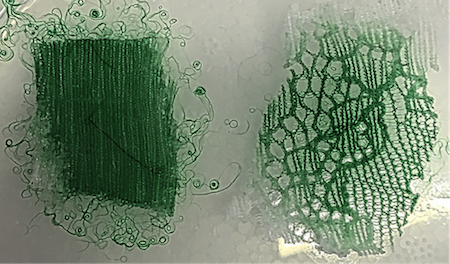Science Fiction
Dictionary
A B C D E F G H I J K L M N O P Q R S T U V W X Y Z
Fluorescent Bacteria Fashion

Victoria Geaney seeks to combine fashion, art, science and technology. She says “the work I produce may not always be wearable or even possible, but the idea and innovation is what I find interesting and is what I am passionate about.”

(Biomaterial fashioned from little more than sunlight and air)
Although purely conceptual, the collection of 2-D print design work explored the idea of fluorescent bacteria and its theoretical application on garments as a biological, glowing print. Aware that there are laws that disallow bacteria to be used in this way, Victoria admitted that “fabric that could be living and emitting light is very interesting!”More recently Victoria together with three other research students Wayne Binitie, Flora Bowden and Trent Kim Future, presented an interdisciplinary exhibition that takes inspiration from nature using non-traditional materials. Attending visitors were given the opportunity to be wowed by the project I mentioned earlier. Called Azzazel, the exhibition showed a collection of bacterial cellulose sculptures that included a dress made from Kishitanni, a photobacterium that is found deep in the ocean and glows a blue colour when alive.
Fans of science fiction may recall the biofabrics from J.G. Ballard's 1970 short story Say Goodbye to the Wind:
The racks of gowns itched and quivered, their colors running into blurred pools. One drawback of bio-fabrics is their extreme sensitivity. Bred originally from the gene stocks of delicate wisterias and mimosas, the woven yard have brought with them something of the vine's remarkable response to atmosphere and touch. The sudden movement of someone nearby, let alone of the wearer, brings an immediate reply from the nerve-like tissues. A dress can change its color and texture in a few seconds, becoming more decollete at the approach of an eager admirer, more formal at a chance meeting with a bank manager.This sensitivity to mood explains the real popularity of bio-fabrics. Clothes are no longer made from dead fibers of fixed color and texture that can approximate only crudely to the vagrant human figure, but from living tissues that adapt themselves to the contours and personality of the wearer. Other advantages are the continued growth of the materials, fed by the body odours and perspriration of the wearer, the sweet liqueurs distilled from her own pores, and the constant renewal of the fibers, repairing any faults or ladders and eliminating the need for washing.
Be sure to check out Ballard's related term inert-wear.
Via fashnerd.
Scroll down for more stories in the same category. (Story submitted 3/2/2017)
Follow this kind of news @Technovelgy.| Email | RSS | Blog It | Stumble | del.icio.us | Digg | Reddit |
Would
you like to contribute a story tip?
It's easy:
Get the URL of the story, and the related sf author, and add
it here.
Comment/Join discussion ( 0 )
Related News Stories - (" Clothing ")
iPhone Pocket All Sold Out!
'A long, strong, slender net...' - Margaret St. Clair, 1949.
Skip Movewear Arc'teryx AI Exoskeleton Pants
'...the terrible Jovian gravity that made each movement an effort.' - Edmond Hamilon, 1930.
Kolors Virtual-Try-On Predicted, And TRIED, By Harry Harrison
'Bill blinked at his own face under the plumed helmet...' - Harry Harrison, 1965
Qore IcePlates Are Personal Cooling Suits
'... underneath they consisted of networks of cooling tubes against the skin.' - Neal Stephenson, 2021.
Technovelgy (that's tech-novel-gee!) is devoted to the creative science inventions and ideas of sf authors. Look for the Invention Category that interests you, the Glossary, the Invention Timeline, or see what's New.
Science Fiction
Timeline
1600-1899
1900-1939
1940's 1950's
1960's 1970's
1980's 1990's
2000's 2010's
Current News
The Zapata Air Scooter Would Be Great In A Science Fiction Story
'Betty's slapdash style.'
Thermostabilized Wet Meat Product (NASA Prototype)
There are no orbiting Michelin stars. Yet.
Could Crystal Batteries Generate Power For Centuries?
'Power could be compressed thus into an inch-square cube of what looked like blue-white ice'
India Ponders Always-On Smartphone Location Tracking
'It is necessary... for your own protection.'
Amazon Will Send You Heinlein's Knockdown Cabin
'It's so light that you can set it up in five minutes by yourself...'
Is It Time To Forbid Human Driving?
'Heavy penalties... were to be applied to any one found driving manually-controlled machines.'
Replace The Smartphone With A Connected Edge Node For AI Inference
'Buy a Little Dingbat... electropen, wrist watch, pocketphone, pocket radio, billfold ... all in one.'
Artificial Skin For Robots Is Coming Right Along
'... an elastic, tinted material that had all the feel and appearance of human flesh and epidermis.'
Robot Guard Dog On Duty
I might also be thinking of K-9 from Doctor Who.
Wearable Artificial Fabric Muscles
'It is remarkable that the long leverages of their machines are in most cases actuated by a sort of sham musculature...'
BrainBridge Concept Transplant Of Human Head Proposed
'Briquet’s head seemed to think that to find and attach a new body to her head was as easy as to fit and sew a new dress.'
Google's Nano Banana Pro Presents Handwritten Math Solutions
'...copy was turned out in a charming and entirely feminine handwriting.'
Edible Meat-Like Fungus Like Barbara Hambly's Slunch?
'It was almost unheard of for slunch to spread that fast...'
Sunday Robotics 'Memo' Bot Has Unique Training Glove
'He then started hand movements of definite pattern...'
Woman Marries Computer, Vonnegut's Dream Comes True
'Men are made of protoplasm... Lasts forever.'
Natural Gait With Prosthetic Connected To Nervous System
'The leg was to function, in a way, as a servo-mechanism operated by Larry’s brain...'
